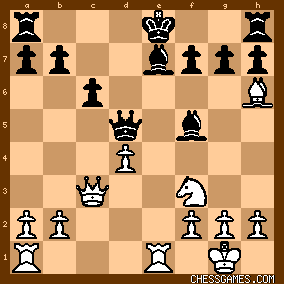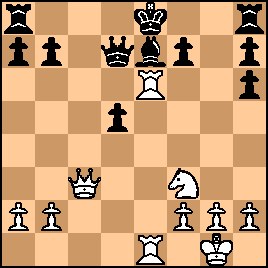|
< Earlier Kibitzing · PAGE 3 OF 3 ·
Later Kibitzing> |
Jun-26-15
 | | Fusilli: <Optimal play> <Browne said he found it OTB and there's no reason to doubt him.> I agree. I think a strong, attacking, imaginative GM like Browne was would find it if he looked for it. And given that the black king is still in the center (and black can't castle yet because of the hanging bishop on e7), he'd be likely to look for it. The train of thought may have been something like this: 1. If I play Re5, then Qd7, and I wish I had R1e1 there; 2. If I did have R1e1, he'd have Be6, and I could play d5, trading that pawn for the g7 pawn, disturbing his king side. (But wait, he may go 0-0-0 and I don't know if I have anything good.) 3. Anyway, my bishop is on the way. I need the bishop out with gain of tempo. 4. Hey!! If it goes to h6, it threatens the pawn on g7, and if he takes it, now my queen will take the rook on h8 instead of the pawn on g7. Just a theory. Browne may have arrived at it with different thinking. But my point is that it is a logical move. Very different from going, point blank, "let's see where I can develop my bishop. What about h6? Does that work?" Which is once thing we'd (with luck) try if they showed us the position as a puzzle with white to play, but in the real world no one tells you "hey, there is a strong move here. Find it!" |
|
| Jun-26-15 | | kevin86: Doubled pawns are just like one; white gets his king in front of the pawn and black's goose is cooked. |
|
| Jun-26-15 | | Howard: I agree that there's little reason to doubt that Browne found 14.Bh6!! over the board, particularly since he spent 45 moves on that move. See The Chess Opening For You (Larry Evans) and also Soltis' book on the U.S.Championships. They both mention that tidbit of info. |
|
| Jun-26-15 | | Petrosianic: This was actually Bisguier's only loss in the tournament. And next year he went undefeated (albeit with 13 draws). It's a far cry from the way he was dropping points left and right in the 60's. |
|
| Jun-26-15 | | Petrosianic: <OhioChessFan>: <Out of curiosity, I tossed the game into Fritz10 and it took him about a half second to find 14. Bh6. I don't believe for a second Browne found it over the board.> I don't understand the argument. If you think Browne got it from a computer, there's a pretty obvious comeback. |
|
| Jun-26-15 | | Petrosianic: Actually, two problems. 1) There were no decent chessplaying computers in 1975, and 2) This game IS in Fritz 10's Database. |
|
| Jun-26-15 | | morfishine: Of course, Browne found <14.Bh6> OTB: He was not a liar and had no reason to start now Nice pun: Browne sure bagged Bisguier!
***** |
|
| Jun-26-15 | | Petrosianic: I'm not a huge Browne fan, but no mistake, this has always been my favorite Browne game. |
|
Jun-26-15
 | | Sally Simpson: Glad to see this game sunk in a hook to others when they first saw it. It's one of them you never forget. Add that game to this game:
W Schmidt vs A Kuligowski, 1978
Note the common idea.
These two games without a shadow of doubt (and I should know) inspired in my own unique and slightly unsound way my 10th move. G.Chandler - R.Austin, Edinburgh 1980.
1. e4 e6 2. d4 d5 3. Nd2 dxe4 4. Nxe4 b6 5. Qf3 c6 6. Bf4 Bb7 7. O-O-O Qd5 8. Kb1 Nd7 9. Bc7 c5 10. Ba6 Bxa6 11. dxc5 Rc8 12. Rxd5 exd5 13. Ng5 Ngf6 14. Qe3+ Be7 15. Bd6 Ng8 16. N1f3 Kf8 17. Qf4 Ngf6 18. Bxe7+ Kxe7 19. Qd6+ Ke8 20. Re1+ Ne4 21. Nxe4 dxe4 22. Rxe4+ Kd8 23. c6 Rc7 24. Qe7+ Kc8 25. Qe8+ Rxe8 26. Rxe8 Not too bad a game, I've just submitted it for here. |
|
| Jun-26-15 | | optimal play: <Fusilli> Insightful post! I wouldn't be surprised if that's just how Browne arrived at Bh6! Developing the Bishop is the next logical move, and either Bd2 or Bg5 is ok, but Browne undoubtedly saw the potential attack along the e-file and worked out how best to exploit it. The result was a surprising and clever move! |
|
| Jun-26-15 | | Petrosianic: <Developing the Bishop is the next logical move, and either Bd2 or Bg5 is ok, but Browne undoubtedly saw the potential attack along the e-file and worked out how best to exploit it.> You're on the right track, but not going far enough. Of course, developing the Bishop is the right idea. But giving it up? Why is that good? How can it be good? It can only be good if you see the value of connecting the Rooks and doubling up on the e7 Bishop. And even then it's only good if you ALSO see the indirect attack on the h8 Rook.
When I saw this game decades ago, I was completely mystified by Bh6. I probably read some line of analysis or other and said "Oh yeah", but still didn't grasp how anyone should be expected to look for that idea, much less see it. When I looked at it in the last few days, it was much more obvious. Granted, I wouldn't have seen it myself OTB, but in hindsight, and knowing in advance that Bh6 is a good move, it's obvious where it leads to. White gives up the piece for two tempos. So, what if Black takes the Bishop? 14. Bh6 gxh6 15. Re5 Qd7 16. Rae1 Be6. The average Class Player could be expected to see this far. But then he'd think so what? Black has consolidated. Everything's safe. So, Bh6 is not a good move. But no. Go one move farther. 16. d5 cxd5. Black still looks safe, right? No. 17. Rxe6 fxe6 18. Qxh8+ Kf7 19. Ne5++. This is the part that most people, including me, would not have seen at Move 14. This is the part that makes it truly brilliant. To have seen BOTH the value of giving up a piece for the two tempos AND the masked attack on h8 that many moves in advance. That's what makes this game great. |
|
| Jun-26-15 | | Petrosianic: And this is why I disagree with the idea that Browne MUST have prepared it because it's just too good to have seen OTB. It's not, it's almost obvious if you see the ideas behind it. What's not obvious is checking it to make sure it works. But in 45 minutes of thought, it is NOT beyond the ability of a strong GM to see it, if he's got the right idea. |
|
Jun-26-15
 | | Bishoprick: Don't see why computers will kill chess. Cars and horses are faster than people. Kangaroos jump farther, etc. Yet we still have track and field events. |
|
| Jun-27-15 | | optimal play: <Petrosianic> Your post really encapsulates the thinking behind this brilliant move. Now we know why Browne spent 45 minutes on it!
Do we know how long Bisguier spent on his reply?
He put up a pretty good fight, but Browne played out the game virtually mistake-free. |
|
| Jun-28-15 | | Howard: Regarding the previous comment, Bisguier spent 50 minutes on his reply. This is stated in Larry Evans' The Chess Opening for You (1976). |
|
| Jun-29-15 | | optimal play: <Howard> Thank you. 5 minutes more than Browne spent on his brilliancy!
Bisguier avoided the mating trap but after 50 minutes of thought, must have realised that he was going to be in for a difficult time, no matter what he played! :O |
|
| Jul-06-15 | | jerseybob: Andy Soltis' game of the week in the Sunday 7-5-15 NY Post, along with an interesting anecdote about the game. |
|
| Jul-06-15 | | Howard: Hmmmm, I can guess what the anecdote probably was.
Soltis states in his book on the history of the U.S. championship, that as Browne thought longer and longer on his 14th move, some of the other players started gathering at the back of the playing area, to exchange comments on what Browne was doing. Some of them apparently knew that the position was "well known" to be even, and they thus thought Browne was just wasting valuable time on his clock. Guess who got the last laugh ! |
|
| Jul-06-15 | | jerseybob: Howard: That was part of it, with Evans making that comment. But earlier on, according to Soltis, Bisguier asked him what to play if Browne played 1.e4 and Soltis suggested a "sacrificial line in the Petroff", but Browne apparently steered the game in another direction. I'm guessing the sacrificial line was the one played earlier that year in Karpov-Korchnoi, sacking the b-pawn. But that's only my guess. |
|
| May-07-20 | | wordfunph: "My other choice is also from 1974, this one from the U.S. Championship. If you ask grandmasters about their best game, nine out of ten will answer, 'I haven't played it yet." In my case, here it is!" - GM Walter Browne (when asked for his best game) Source: Chess Life 2005 August |
|
| May-07-20 | | Granny O Doul: Not that there's a real debate going on, but I'm trying to imagine Browne spending 45 minutes pretending to be thinking. Would he still be doing his whole Browne thing? |
|
| May-07-20 | | stoy: According to the engine on this website the evaluation is +0.50 if black takes the bishop with g x h6. |
|
| Oct-22-23 | | Gaito: 
click for larger viewBLACK TO MOVE
In case of 14...gxh6, there might have followed 15.Re5 Qd7 16.Rae1 Be6 17.d5! cxd5 18.Rxe6
(see next diagram)

click for larger viewAnd further, if 18...fxe6 19.Qxh8+ Bf8 20.Qf6 Be7 21.Rxe6 Rc8 22.g3, and Black's game is in ruins (Computer evaluation by Komodo 13 is +3.13) |
|
| Nov-07-23 | | Caissanist: Chess24 has all of Browne's annotations for this game, taken from his autobiography <The Stress of Chess (and its Infinite Finesse)>: https://chess24.com/en/read/news/re... |
|
Oct-07-24
 | | Knightf7mate: Agadmator reviewed this game a few days ago. It’s very instructive as well as informative. Also be sure to read the comments which include some recollections of people who witnessed the game. https://m.youtube.com/watch?v=jvvnb... |
|
 |
 |
|
< Earlier Kibitzing · PAGE 3 OF 3 ·
Later Kibitzing> |





